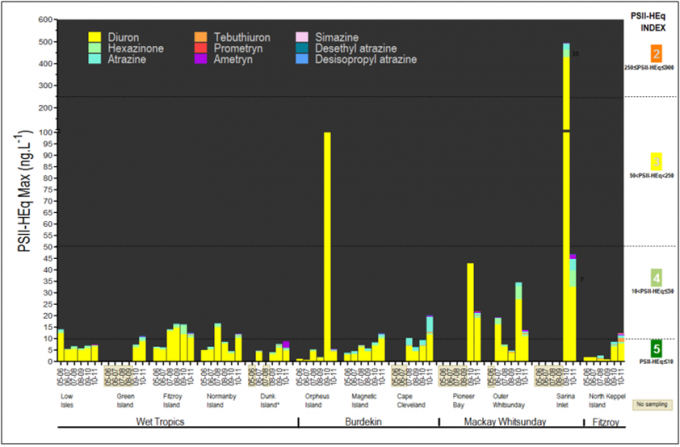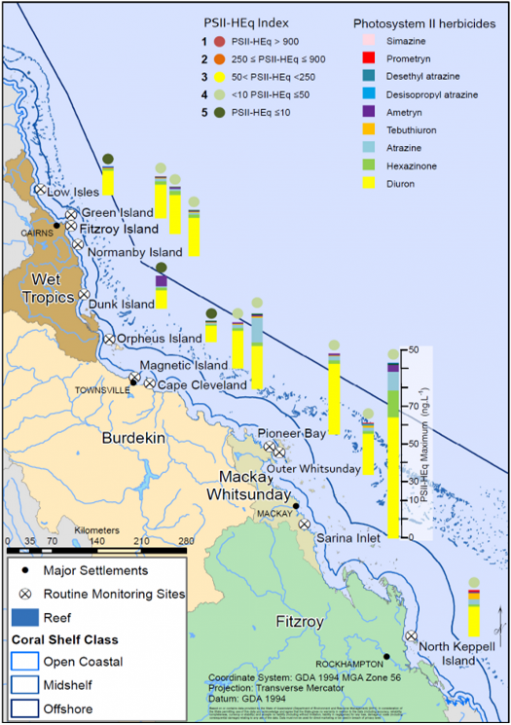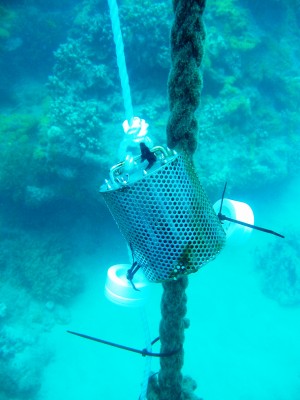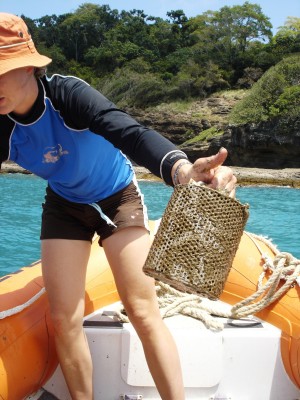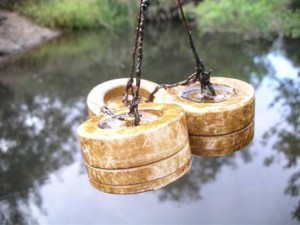Reef Rescue Marine Monitoring Program - Project - Pesticide monitoring in inshore waters of the Great Barrier Reef using both time-integrated and event monitoring techniques (Entox UQ)

This page is archived and only represents the MMP up to 2012. The new main web page for all of the MMP is managed by GBRMPA.
The transport of pesticides from land-based applications to the coastal waters of Queensland is considered a potential risk to the health and heritage values of the Great Barrier Reef ecosystem. At sites near the Queensland coast pesticides and herbicides from agricultural sources have been detected throughout the year (Figure 1). The aim of this component of the MMP is to assess trends in the concentrations of specific herbicides and pesticides, primarily through routine monitoring at sites within 20km of the coast.
In 2010-2011, trends in pesticide exposure were assessed at twelve sites (Low Isles, Green Island, Fitzroy Island, Normanby Island, Dunk Island, Orpheus Island, Magnetic Island, Cape Cleveland, Pioneer Bay, Outer Whitsunday, Sarina Inlet, North Keppel Island) across four Natural Resource Management regions (Wet Tropics, Burdekin, Mackay Whitsunday, Fitzroy) (Figure 2). Entox conducted monitoring activities within two components of the MMP: Inshore Marine Water Quality Monitoring and Assessment of Terrestrial Run-off Entering the Reef.
Results from 2010-2011 confirmed that the herbicide diuron continues to be the dominant contaminant in GBR waters. Wet season discharges during these years were high to extreme. Exposures to diuron and other PSII herbicides were more consistently elevated on the GBR compared to drier months (Figure 1), confirming that river discharge increases exposure of reefs to chemicals used in agriculture.
Pesticide exposure was assessed from passive samplers that accumulate organic chemicals such as pesticides and herbicides from water via diffusion. The concentration of the chemical in the water can be estimated from the amount of organic chemical accumulated within a given period using calibration data obtained under laboratory conditions (Booij et al., 2007). Passive sampling techniques offer cost effective time-integrated monitoring of both temporal and spatial variation in pesticide exposure in the often remote locations on the GBR (Shaw and Mueller, 2005).
Herbicides including diuron and atrazine are classed as Photosystem II (PSII) inhibitors. An indicator developed from scientific studies on the ecological effects of PS11 chemicals is used as a proxy for risk of exposure to PS11 herbicides to simplify reporting of PS11 concentration and potency (Table 1). The concentration of herbicides is expressed as a PSII herbicide equivalent concentration (PSII-HEq) based on the reference PSII herbicide diuron.
|
Category |
Concentration (ng.L-1) |
Description |
|---|---|---|
|
5 |
PSII-HEq ≤10 |
No published scientific papers that demonstrate any effects on plants or animals based on toxicity or a reduction in photosynthesis. The upper limit of this category is also the detection limit for pesticide concentrations determined in field collected water samples |
|
4 |
10 < PSII-HEq ≤50 |
Published scientific observations of reduced photosynthesis for two diatoms. |
|
3 |
50 < PSII-HEq < 250 |
Published scientific observations of reduced photosynthesis for two seagrass species and three diatoms. |
|
2 |
250 ≤ PSII-HEq ≤900 |
Published scientific observations of reduced photosynthesis for three coral species. |
|
1 |
PSII-HEq > 900 |
Published scientific papers that demonstrate effects on the growth and death of aquatic plants and animals exposed to the pesticide. This concentration represents a level at which 99 per cent of tropical marine plants and animals are protected, using diuron as the reference chemical. |
Table 1: PSII-Herbicide Equivalent Index developed as a indicator for reporting of PSII herbicides across the Reef Rescue Marine Monitoring Program.
Key findings for the 2010-2011 monitoring year
- The PSII herbicide diuron continues to be the dominant contributor to PSII-HEq at all sites due to both its relative abundance and potency as a PSII inhibitor.
- Tebuthiuron was the only individual PSII herbicide which exceeded Water Quality Guidelines for the Great Barrier Reef Marine Park 2010 (GBRMPA 2010) at a routine monitoring site (North Keppel Island in the Fitzroy Region).
- PSII herbicides detected with higher frequency at routine monitoring sites in 2010-2011 using passive samplers included bromacil, ametryn and prometryn, albeit typically < 2 ng.L-1.
- PSII-HEq maximums (Max) were predominantly Category 4 for many sites which are more typically Category 5 across the GBR on the PSII-HEq Index.
- The most notable increases in PSII-HEq Max occurred in the Burdekin (factors of 2.2 – 3.2) and the Fitzroy Region (factor of 12).
- While the increases in PSII-HEq Max were not always significant, there was a noticeable and consistent increase in the wet season average PSII-HEq at nearly every site, indicating that exposures to PSII herbicides were more consistently elevated on the GBR across this extraordinary wet season.
The most abundant and frequently detected PSII herbicides at routine sites using time-integrated passive sampling in each region were:
- Wet Tropics– diuron, atrazine and hexazinone – higher concentrations of diuron (up to 6.5 -10 ng.L-1).
- Burdekin– atrazine, diuron, and tebuthiuron – atrazine concentrations (up to 42 ng.L-1) exceeding diuron concentrations (up to 12 ng.L-1) at Cape Cleveland.
- Mackay Whitsunday– diuron, atrazine, hexazinone and tebuthiuron – higher concentrations of diuron (up to 11 - 33 ng.L-1).
- Fitzroy– diuron, atrazine and tebuthiuron – tebuthiuron (up to 20 ng.L-1) and atrazine (up to 8.0 ng.L-1) concentrations can be higher or similar to the concentration of diuron (up to 7.9 ng.L-1) when impacted by flood waters.
2010-2011 was characterized by extreme weather events, with both cyclones impacting specific areas and rivers in all regions flooding from between 1.5 to more than 3 times higher than long-term median discharge. The relationship between increased discharge and increased risk of exposure to PSII herbicides has been demonstrated using data from this MMP. The result of this increased risk of exposure is evident with each region having Category 4 maximums on the PSII-HEq Index in 2010-2011.
More Information
References
GBRMPA (2010). Water Quality Guidelines for the Great Barrier Reef Marine Park. Revised Edition 2010. Townsville, Great Barrier Reef Marine Park Authority.
Haynes, D., Michalek-Wagner, K.,(2000). Water quality in the Great Barrier Reef World Heritage Area: Past perspective, current issue and new research directions. Marine Pollution Bulletin 41, 428-434.
Booij, K., Vrana, B., Huckins, J.N., (2007). Theory modelling and calibration of passive samplers used in water monitoring., in: G. Mills, R. Greenwood, B. Vrana (Eds.), Passive Sampling Techniques. Elsevier
Shaw, M., Mueller, J.F., 2005. Preliminary evaluation of the occurrence of herbicides and PAHs in the Wet Tropics region of the Great Barrier Reef, Australia, using passive samplers. Marine Pollution Bulletin 51, 876–881.
Reports from this project
These reports cover the work of this project in detail:
- Inshore pesticide monitoring 2010 - 2011 (4.2 MB)
- Inshore pesticide monitoring 2009 - 2010 (5.6 MB)
- Inshore pesticide monitoring 2008 - 2009 (3.2 MB)
- Inshore pesticide monitoring 2007 - 2008 (4.9 MB)
- River and inshore pesticide monitoring 2006 - 2007 (1.7 MB)
Maps from this project
Maps for this dataset are available in the e-Atlas web mapping client under the path Environment/GBR: Inshore Pesticide Monitoring (Entox, UQ). The following layers are available for each year from 2005-2011.
- Max Annual PSII Herbicide Equivalent (ng/L)(Entox, UQ)
- Max Annual PSII Herbicide Equivalent Index (ng/L)(Entox, UQ)
- Average Dry PSII Heq (ng/L)
- Average Wet PSII Heq (ng/L)
Dataset meta-data
The data collected by this project is described in more detail in the following meta-data records:
- Mueller, Jochen, Entox, Pesticide monitoring in inshore waters of the Great Barrier Reef using both time-integrated and event monitoring techniques






